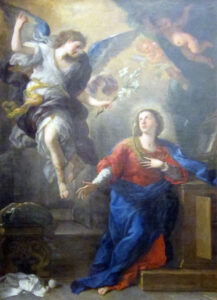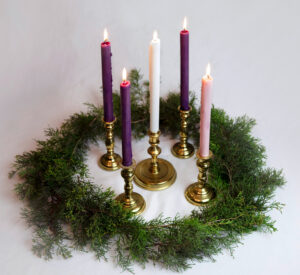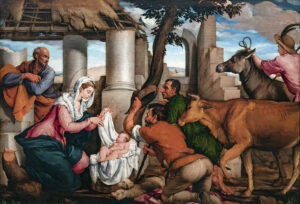By Dr. Don Bierle, FaithSearch President
And the angel answered and said to her, “The Holy Spirit will come upon you, and the power of the Most High will overshadow you; and for that reason the holy offspring shall be called the Son of God…” (Luke 1:35-38).
Jesus is “the image of the invisible God… For in Him all the fullness of Deity dwells in bodily form” (Colossians 1:15; 2:9).
Thanksgiving Anticipates Advent
Thanksgiving may come first in our calendar today, but Christmas gives it its fullest meaning. Therefore, it is appropriate that Christians gathering for Thanksgiving would anticipate celebrating the advent of our Savior Jesus Christ.
Churches and Christian families do so with a centuries-old Christian tradition called the Advent wreath. It consists of a wreath with four candles in a circle around a fifth larger candle in the center. One candle is lit each week of Advent (this year on December 1, 8, 15, and 22), symbolizing the lighted path which leads to the ultimate spiritual light of the world. The birth of the Savior Jesus Christ is represented by the fifth candle, which is lit on Christmas eve.
The four candles represent the virtues which Jesus brings: hope, peace, joy, and love, in that order. The first, second, and fourth candles are purple, the primary color of Advent symbolizing royalty. The third candle is pink, the liturgical color for joy. The larger center candle, symbolizing Jesus’ birth, is white for purity or perfection.
Candle One: HOPE
Sometimes called the “Prophecy Candle,” it points to the long line of God’s promises to redeem us from our sin and death into the glorious eternity He has prepared for His children. Isaiah prophesied, “The people who walk in darkness will see a great light… For a child will be born to us, a son will be given to us” (9:2, 6). Luke’s Gospel revealed the prophecy’s significance:
“…for today in the city of David there has been born for you a Savior who is Christ the Lord” (2:11).
Candle Two: PEACE
Often called the “Bethlehem Candle,” the second Advent candle reminds us of Mary and Joseph’s journey to Bethlehem and anticipation of their first-born Son. Isaiah identified the significance, “And His name will be called… Prince of Peace…” Furthermore, Isaiah extended the promise, “There will be no end to the increase of His government or of peace… from then on and forevermore” (9:6-7). The destruction caused by sin may be manifest now, but Jesus is coming again, and so is His kingdom of peace (John 14:27; 16:33).
Candle Three: JOY
As we come closer to Christmas eve, our joy grows more and more. Even the angel who brought the message from God so many years ago was excited, “…I bring you good news of a great joy which shall be for all the people…” (Luke 2:10). The third candle takes us back to the joyful anticipation of the shepherds who went to see Jesus in Bethlehem, thus it is often referred to as the “Shepherds’ Candle.”
The Psalmist anticipates our own response: “Let us come before His presence with thanksgiving; Let us shout joyfully to Him with psalms” (95:2).
Candle Four: LOVE
The circular shape of the Advent wreath symbolizes God’s infinite love for us. That is why the fourth candle, called the “Angel’s candle,” points to the true Light of the world, Jesus. The apostle John affirmed that God’s love is manifested in Jesus, “For God so loved the world, that He gave His only begotten Son…” (John 3:16), and “We know love by this, that He laid down His life for us…” (1 John 3:16).
Candle Five: JESUS
Science has identified the electromagnetic spectrum which includes all the colors of the visible portion of light, from red to violet. The candles are purple and pink because they reflect only that portion of the visible spectrum, symbolically reflecting only hope, peace, joy, or love.
In contrast, the white candle reflects them all, the “light” of the entire spectrum. Jesus said, “I am the light of the world, he who follows Me… shall have the light of life” (John 8:12). In Jesus, we can have it all – hope, peace, joy, and love. Indeed, confessing our sin and professing our faith in Him, God’s Word declares an amazing truth,
And although you were formerly alienated and hostile in mind, engaged in evil deeds, yet He has now reconciled you in His fleshly body through death, in order to present you before Him holy and blameless and beyond reproach (Colossians 1:21-22).
Feast your soul on His perfection—and ours, by His grace—this Thanksgiving and Christmas!






